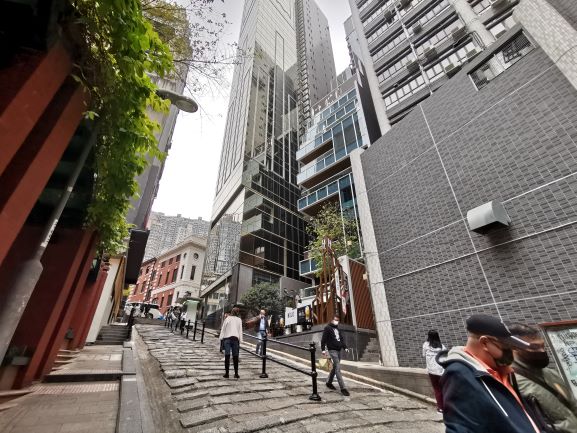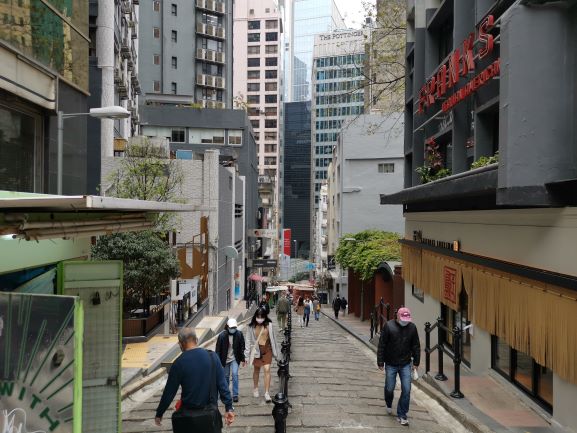SPARROW, DIR. JOHNNIE TO (2008)
Pottinger Street, Central District, Hong Kong

Kei using his vintage Rolleiflex to take photos at Pottinger Street. Scenes from the Milkyway Image’s Sparrow 2008, directed by Johnnie To.
Sparrow (文雀) is a film produced and directed by Johnnie To Kei-fung and was released by the Milkyway Image in June 2008. It tells a story about how an attractive female stranger suddenly appears in the life of four pickpockets. Kei, as the leader of the pickpockets’ team, enjoys taking photos with his vintage Rolleiflex. One day when he is taking photos at Pottinger Street, a beauty comes into his view. She runs along the stone slabs street in 4-inch high heels. All these scenes are carefully recorded by Kei, without knowing that they will meet again in the future.
Throughout the whole film, sparrows appear from time to time, not only as a kind of bird but also as an important metaphor. The beauty Chun-lei is like a sparrow: She dashes into Kei and his partner’s life and flies away soon without leaving anything. Several male characters fall in love with her but cannot “catch” this lovely sparrow. Having a study on Johnnie To’s other movies, I think sparrow is also a metaphor for the disappearing traditional Hong Kong culture. The hawker stalls, messy back alleys, old bicycles, together with many other views and objects are disappearing, leaving only some photos in our camera.
How is the Hong Kong culture disappearing like a sparrow flying away? This phenomenon is clearly shown in the difference between the movie scenes in 2008 and the fieldwork photographs in 2021. In 2008, Pottinger Street was one of the few places which still preserve the original Hong Kong culture well, although there were some modern buildings surrounded. From the scenes in the film, Chun-lei runs along the street with traditional hawker stalls and old buildings as backgrounds. All these elements help structure a street with history and culture. However, in comparison, after 11 years of development, several old buildings were demolished and replaced by modern iron and concrete. A number of hawker stalls are not there anymore, leaving the rest modernized with steel structure. The facade and furniture of all the stores are now in modern style, using various material with vivid colour.
These differences reveal the development of urban Hong Kong and the disappearance of some traditional elements. Urbanization and modernization are inevitable but this gives rise to several issues. As urban construction goes on, the city’s original elements and features gradually disappear. Since modernization itself does not contain any personal memory, historic value, or traditions, it causes difficulties for Hong Kong residents to identify themselves. Preserving the unique traditional elements is like keeping the sparrow: we appreciate and respect our history rather than taking it as temporary stuff.

- Chun-lei at Pottinger Street. Scenes from Sparrow, 2008, directed by Johnnie To.

Chun-lei running along the stone slabs in high heels. Scenes from Sparrow, 2008, directed by Johnnie To.


Left: View with the same location and direction as the scene of Kei taking photos.
Right: View with the same location and direction as the scene of Chun-lei looking back.
— Lin Wei Alex, 3035767554
You made a special decision to start the discussion with the symbol of a sparrow instead of focusing on the space of Pottinger Street. Although it would be compelling to see how you discuss the choice of site and how it assists the film, you did put the effort into looking at the surroundings and backgrounds on Pottinger Street to explain your analysis on using sparrow to symbolize disappearance. Do you think these hawkers were on Pottinger Street in 2008? Have the past 11 years caused their disappearance or it was simply Johnnie To’s choice to let them reappear in the 2008 film? That might allow you to discuss the role of film in resisting disappearance. A more in-depth analysis of disappearance by applying Abaas’ theories would help you look deeper into the film and the reality.